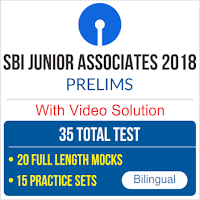Following the study plan for SBI PO Preliminary Examination 2018, the second week starts with practice questions on Puzzles, coding-decoding and Syllogism. To ensure proper preparation of the section we advise you to go through all the questions sincerely and try to attempt each one of them. Afterward, match your solutions and the approach with the one that would be provided later. Practice more and more questions on the same section to enhance your grip over the topics. Following is the Reasoning Ability quiz to help you practice with the best of latest pattern questions.
Directions (1-5): Study the information carefully and answer the questions given below.
Eight persons P, Q, R, S, T, U, V, and W going for the vacation on different month viz. June, July, August and September. They are going on two different dates of the same year 22nd and 29th. Only one person going on one date. All the given information is not necessary in the same order. Only two persons going for the vacation after T. U going for the vacation in the moth which has 30day. There are two persons going for the vacation between U and V who does not going in the same month with T. R does not going for the vacation in the month which has 31 days. P is not going in the same date and month as T going. There is one-month gap between V and W who going on odd date. S going after U and R but before Q but not immediately before. Q does not go in the month which has 31 days.
Q1. Who among the following person going for the vacation on 29th June?
(a) U
(b) R
(c) W
(d) S
(e) P
Q2. How many persons going after S?
(a) One
(b) Two
(c) Three
(d) More than three
(e) None
Q3. How many persons goes between P and the person who going on 29th July?
(a) None
(b) One
(c) Two
(d) Three
(e) More than three
Q4. Which of the following combination is true regarding the given statement?
(a) August-P
(b) June-V
(c) September-Q
(d) July-T
(e) None of these.
Q5. Four of the following five are alike in a certain way so form a group find the one which does not belong to that group?
(a) U
(b) R
(c) Q
(d) W
(e) S
Directions (6-8): A person starts his journey from point X towards east direction. After walking for 3km he reached point P. From there he takes a right turn and walk 6km to reach point Q. Then turn toward his right and walk 5km to reach point R.
Q6. If a person Start from X towards south and reached point S which is in the Straight line RSQ so, what is the distance between X and S?
(a) 5km
(b) 6km
(c) 7km
(d) Can’t be determined
(e) None of these.
Q7. What is the shortest distance between point R to point P?
(a) √60
(b) 61
(c) √61
(d) 2√61
(e) None of these
Q8. In which direction is point R with respect to point P?
(a) South
(b) West
(c) North east
(d) South east
(e) None of these.
Directions (9-13): Study the following information to answer the given questions.
In a certain code language,
‘too close to call’ is written as ‘G3 X5 G2 X4’
‘not much is required’ is written as ‘M3 N4 R2 I8
‘girls demand freedom’ is written as ‘T5 W6 U7
Q9. In the given code language, what does the code ‘V4’ stand for?
(a) foul
(b) devil
(c) evil
(d) feminism
(e) fierce
Q10. What is the code for ‘curse’ in the given code language?
(a) W5
(b) B5
(c) W4
(d) X5
(e) None of these
Q11. What is the code for ‘F8’ in the given code language?
(a) evil
(b) career
(c) devil
(d) umbrella
(e) None of these
Q12. What is the code for ‘society’ in the given code language?
(a) H7
(b) T5
(c) K5
(d) T6
(e) None of these
Q13. What is the code for ‘quality’ in that give language?
(a) B4
(b) L5
(c) I6
(d) R6
(e) None of these
Directions (14-15): In each question below are given statements followed by two conclusions numbered (i) and (ii). You have to assume everything in the statements to be true even if they seem to be at variance with commonly known facts and then find out which of the given conclusions logically follow from the statements, disregarding commonly known facts.
Q14. Statements:
Some brick are greed.
No greed is a dose.
All doses are feed.
Conclusions:
(i) Some brick are not doses.
(ii) No feed are a greed.
(a) Only conclusion I follow
(b) Only conclusion II follow
(c) Either I or II follow
(d) Neither I nor II follow
(e) Both I and II follow.
Q15. Statements:
All bowl is foul.
Some foul are crabs.
All crabs are pawn.
Conclusions:
(i) All bowl being pawn is a possibility.
(ii) All crabs being bowl is a possibility.
(a) Only conclusion I follow
(b) Only conclusion II follow
(c) Either I or II follow
(d) Neither I nor II follow
(e) Both I and II follow.






 GA Capsule for SBI Clerk Mains 2025, Dow...
GA Capsule for SBI Clerk Mains 2025, Dow...
 The Hindu Review October 2022: Download ...
The Hindu Review October 2022: Download ...
 Without These Documents, Your Bank Exam ...
Without These Documents, Your Bank Exam ...





